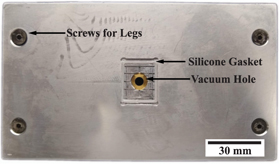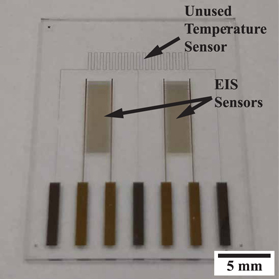In the recently published ‘3D printing on glass for direct sensor integration,’ authors M. Neubauer, M. McGlennen, S. Thomas and S. Warnat explore further methods for refining 3D printed microfluidics. In this study, the researchers create an approach for fabricating channels onto glass substrates.
As additive manufacturing processes become a realistic method for fabricating fluidic devices, using vat polymerization ( they abbreviate it VPP), stereolithography (SLA), and digital light processing (DLP), researchers have many different options before them for research like integration of sensors. Glass substrates offer a way for making channels that are not only optically transparent but offer a way to embed a glass-based impedance-conductivity sensor within the 3D printed flow channel.
For the 3D printing process, the researchers chose a MiiCraft 50, along with clear BV007 resin.

Modified build plate with insert for glass slide and silicone gasket and vacuum hole to hold glass substrate in place during printing.
“Using a silicone gasket and a diaphragm vacuum pump (Masis, GZ35-12) a glass slide could be held in place during the printing process and quickly released afterwards. The glass slide protruded slightly from the plane of the build plate; this distance was measured and accounted for in the printer software,” explained the researchers.
“Mounting the glass flush with the edge of the insert made it possible to reference the edge of the glass in the software so that prints could be precisely aligned to the edges of the glass itself with better than 100 μm repeatability.”
The research team selected sample applications to match the sensors, but they could also be used in a wide range of applications. The build plate, silane treatment, and more, could be used with other hardware and materials.
“The glass substrate is itself a part of the channel and allows ideal optical access. Resistance measurements, Raman spectroscopy, and impedance spectra show that sensor properties are unaffected, and no resin or chemicals are left on the sensing surface after printing on the sensor. Viability of materials other than Au could be tested for other applications with similar techniques,” concluded the researchers.
“Applying the same methods for device realization, any number of devices can be integrating with a 3D printed structure. The limitations on device design generally are associated with the 3D printer, its resolution and compatible resins. These issues will become less prevalent as the technology in this rapidly advancing field improves and becomes available. Overall, this process will benefit from all advances in 3D printing technologies, becoming an increasingly viable avenue for sensor-packaging integration for bio-sensing.”
3D printing microfluidics is becoming an extensive area of study, from analyzing and solving challenges within to exploring the connection with other materials and processes, to include bioprinting. What do you think of this news? Let us know your thoughts; join the discussion of this and other 3D printing topics at 3DPrintBoard.com.

Fabrication process and image of device. (a) Flow chart of device fabrication. (b) Exploded view of designed sensor packaging. (c) Assembled device with tubing and magnets.
Subscribe to Our Email Newsletter
Stay up-to-date on all the latest news from the 3D printing industry and receive information and offers from third party vendors.
You May Also Like
3D Printing Unpeeled: $5000 Cold Spray 3D Printer, Roland DGA & Living Materials
The AeroForge is a $5000 cold spray metal printer for copper made by a student team at Rice University. In a paper for ACS Central Science a team from Nanjing...
3D Printing Webinar and Event Roundup: April 28, 2024
In this week’s 3D Printing Webinar and Event Roundup, the Ceramics Expo is taking place in Michigan, Stratasys continues its advanced training courses, and SPE is holding a Polymer Characterization...
Meltio Expands Global Reach with New Partnerships in the Americas and Europe
Spanish 3D printing manufacturer Meltio has expanded its sales network across the globe. With the addition of three new partners in the United States, Brazil, Argentina, and Italy, Meltio aims...
US Army Corps of Engineers Taps Lincoln Electric & Eaton for Largest 3D Printed US Civil Works Part
The Soo Locks sit on the US-Canadian border, enabling maritime travel between Lake Superior and Lake Huron, from which ships can reach the rest of the Great Lakes. Crafts carrying...































